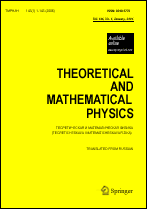|
This article is cited in 2 scientific papers (total in 2 papers)
The role of Majorana-like bound states in the Andreev reflection and the Josephson effect in the case of a topological insulator
T. S. Tinyukovaa, Yu. P. Chuburinb
a Udmurt State University, Izhevsk,
Russia
b Udmurt Federal Research Center, Ural Branch, RAS, Izhevsk,
Russia
Abstract:
We analytically investigate Andreev bound states with a near-zero energy in a one-dimensional “normal metal–superconductor” structure formed at the boundary of a two-dimensional topological insulator with superconductivity induced by the proximity effect in the presence of a Zeeman field. We assume that the system is open, which leads to a finite lifetime of bound states. We prove that in the topological and trivial phases, there are two Andreev bound states that are stable inside the superconductor, and their superpositions form two Majorana-like bound states. But the ideal Andreev reflection in the topological phase is caused not by Majorana states but by the presence of two Andreev bound states with opposite spins in the superconductor (one of them plays the role of a Majorana state). In the “superconductor–normal metal–superconductor” structure at the topological insulator boundary for a small superconducting gap, we study the Josephson effect using a rigorous approach. In particular, we find an analytic expression for the current–phase relation and also describe wave functions in the case of zero current and the maximum Josephson superconducting current. At the maximum current in the absence of a potential, Majorana bound states arise. It turns out that under certain conditions, bound states with a finite lifetime act as current carriers.
Keywords:
Bogoliubov–de Gennes Hamiltonian, spectrum, scattering problem, transmission probability, Majorana bound state, Andreev bound state, Josephson effect.
Received: 03.06.2019
Revised: 05.07.2019
Citation:
T. S. Tinyukova, Yu. P. Chuburin, “The role of Majorana-like bound states in the Andreev reflection and the Josephson effect in the case of a topological insulator”, TMF, 202:1 (2020), 81–97; Theoret. and Math. Phys., 202:1 (2020), 72–88
Linking options:
https://www.mathnet.ru/eng/tmf9761https://doi.org/10.4213/tmf9761 https://www.mathnet.ru/eng/tmf/v202/i1/p81
|


| Statistics & downloads: |
| Abstract page: | 300 | | Full-text PDF : | 50 | | References: | 30 | | First page: | 9 |
|




 Contact us:
Contact us: Terms of Use
Terms of Use
 Registration to the website
Registration to the website Logotypes
Logotypes








 Citation in format
Citation in format 
